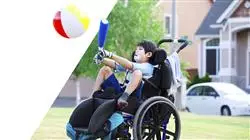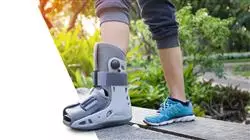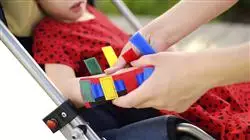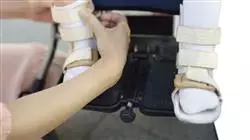University certificate
The world's largest faculty of physiotherapy”
Why study at TECH?
A Hybrid professional master’s degree that will take you in just 12 months to achieve an effective update in Pediatric Orthopedics"

Thanks to advances in technology and medical research, physical therapy professionals can offer effective and personalized solutions to musculoskeletal problems in children and adolescents. Therefore, pediatric orthopedics covers a wide range of pathologies, from scoliosis to rheumatic diseases, including congenital malformations and traumatic injuries.
Updating knowledge in this field has become essential for physical therapists who wish to offer a complete and effective treatment to their pediatric patients. For this reason, this Hybrid professional master’s degree in Pediatric Orthopedics of TECH is born, which offers a complete update in this specialty, with innovative pedagogical tools and an internship of 3 weeks in a first level health center.
A program includes topics such as evaluation of the pediatric patient, treatment of the most common orthopedic pathologies, application of advanced technologies in rehabilitation and injury prevention. In addition, the students will have the opportunity to have an effective update with experts in this field and to apply the theoretical framework addressed in a real clinical setting.
Undoubtedly, this academic institution offers a perfect opportunity for a comprehensive update through an unparalleled and flexible academic option that adapts to the real needs of updating physical therapists.
Take a step forward in your professional career and incorporate the most relevant technical advances in the care of children with muscular dystrophies"
This Hybrid professional master’s degree in Pediatric Orthopedics contains the most complete and up-to-date scientific program on the market. The most important features include:
- Development of more than 100 cases presented by physiotherapy professionals who are experts in approaching minor patients requiring pediatric orthopedics
- Its graphic, schematic and practical contents provide scientific and assistance information on those medical disciplines that are essential for professional practice
- Patient assessment and integration of the latest recommendations for successful integration of therapeutic procedures
- Comprehensive systematized action plans for the main pathologies
- Presentation of practical workshops on diagnostic techniques
- An algorithm-based interactive learning system for decision-making in the clinical situations presented throughout the course
- Approach to the different lesions according to the characteristics of the population
- With a special emphasis on evidence-based medicine and research methods in patient recovery
- All of this will be complemented by theoretical lessons, questions to the expert, debate forums on controversial topics, and individual reflection assignments
- Content that is accessible from any fixed or portable device with an Internet connection
- In addition, you will be able to do a clinical internship in one of the best clinical and rehabilitation centers in the world
Improve the quality of life of children with motor disabilities through this Hybrid professional master’s degree in Pediatric Orthopedics"
In this proposal for a Hybrid professional master’s degree, of a professionalizing nature and online format, the program is aimed at updating physiotherapist who perform their functions in intensive care units, and who require a high level of qualification. The contents are based on the latest scientific evidence, and oriented in a educational way to integrate practice, and the theoretical-practical elements will facilitate the updating of knowledge and will allow decision making in the patient management.
Thanks to their multimedia content developed with the latest educational technology, they will allow the physiotherapy professional to obtain situated and contextual learning, which means a simulated environment that will provide immersive learning programmed to train in real situations. This program is designed around Problem-Based Learning, whereby the professional must try to solve the different professional practice situations that arise throughout the program. For this purpose, the students will be assisted by an innovative interactive video system created by renowned and experienced experts.
Get a complete update on the most innovative techniques for the treatment of orthopedic injuries in children through this university program"

With this program you will be up to date on the techniques used to treat pediatric patients with syndromic diseases"
Teaching Planning
The program of studies of this university degree has an exhaustive syllabus based on the most recent scientific evidence on pediatric orthopedics. In this way, the graduate will have the guarantee of accessing an advanced qualification on the different orthopedic conditions and pathologies and their approach from the physiotherapy point of view. All this, in addition, with innovative teaching material, accessible 24 hours a day, from a digital device with internet connection. The culmination of this program is the internship in a prestigious center, which undoubtedly distinguishes this program.

A program that includes the most advanced syllabus and the most innovative didactic material, available 24 hours a day"
Module 1. Child Orthopedics
1.1. Clinical History of Children and their Examination
1.1.1. The Examination of Infants
1.1.2. The Examination of Teenagers
1.2. Radiodiagnostics
1.3. Characteristics of Children’s Bones and Bone Growth
1.4. Angular Deformities
1.4.1. Genu Varum
1.4.2. Genu Valgum
1.4.3. Recurvatum
1.4.4. Antecurvatum
1.5. Torsional Deformities
1.5.1. Femoral Anteversion
1.5.2. Tibial Torsion
1.6. Length Discrepancy
1.7. Pediatric Lamenes
1.8. Apophysitis and Enthesitis
1.9. Pediatric Fractures
1.10. Pediatric Immobilizations and Orthoses
1.10.1. Types of Immobilizations
1.10.2. Duration of the Immobilizations
Module 2. Upper Limb
2.1. Agenesis and Transverse Defects
2.2. Radial longitudinal deficiency. Hypoplasias and Agenesis of the Thumb
2.3. Ulnar Longitudinal Deficiency. Proximal Radioulnar Synostosis
2.4. Preaxial and Postaxial Polydactyly
2.5. Syndactyly. Macrodactyly Clinodactyly. Camptodactyly. Kirner’s Deformity
2.6. Amniotic Band Syndrome
2.7. Madelung’s Deformity
2.8. Arthrogryposis
2.9. Obstetric Brachial Palsy
2.10. Tumors Affecting the Pediatric Hand: Osteochondromatosis, Enchondromatosis and Soft Tissue Tumors
Module 3. Hip
3.1. Embryology, Anatomy and Biomechanics of the Hip
3.2. Transient Synovitis of the Hip
3.2.1. Etiopathogenesis
3.2.2. Differential Diagnosis
3.2.3. Orthopedic Management
3.3. Developmental Dysplasia of the Hip in Children under 18 Months of Age
3.3.1. Concept. Historical Recollection
3.3.2. Dysplasia in Children Under 6 Months of Age
3.3.2.1. Diagnostic Examination
3.3.2.2. Hip Ultrasound. Methods and Interpretation
3.3.2.3. Therapeutic Orientation
3.3.3. Dysplasia in Children aged 6-12 Months
3.3.3.1. Clinical and Radiological Diagnosis
3.3.3.2. Treatment
3.3.4. Dysplasia in Walking Children (>12 Months)
3.3.4.1. Late Diagnosis Errors
3.3.4.2. Treatment Management
3.4. Developmental Dysplasia of the Hip in Children over 18 Months Old
3.4.1. Definition and Natural History
3.4.2. Etiology and Clinical Manifestations
3.4.3. Clinical and Radiological Classification. Hip Risk Factors
3.4.4. Differential Diagnosis
3.4.5. Treatment
3.5. Hip Dysplasia in Older Children and Teenagers
3.5.1. Causes and Types
3.5.2. Diagnostic Guidance
3.5.2.1. Teenage Hip Dysplasia Radiology
3.5.2.2. Complementary Studies of Dysplasia: MRI, Arthro rmn, tac, etc
3.5.3. Treatment
3.5.3.1. Arthroscopic Treatment
3.5.3.2. Open Surgery
3.5.3.2.1. Pelvic Osteotomies. Techniques and Guidelines
3.5.3.2.2. Femoral Osteotomies. Techniques and Guidelines
3.6. Legg-Calvé-Perthes Disease
3.6.1. Perthes After-Effects
3.6.2. Syndromic Hip
3.6.3. Chondrolysis
3.6.4. Sequelae of Arthritis (Septic, Rheumatic Diseases, etc.)
3.7. Epiphysiolysis of the Femoral Head
3.7.1. Diagnosis. The way they are formed
3.7.2. Etiopathogenesis
3.7.3. Types of Epiphysiolysis. Pathophysiological Mechanism
3.7.4. Surgical Management
3.7.4.1. In Situ Reduction
3.7.4.2. Modified Dunn
3.7.4.3. Late Treatment
3.8. Coxa vara
3.8.1. Etiopathogenesis
3.8.2. Differential Diagnosis
3.8.3. Treatment
3.9. Musculoskeletal Pain Around the Hips in Children
3.9.1. Snapping Hip Syndrome
3.9.1.1. Types of Snapping (Internal, External)
3.9.1.2. Treatment
3.9.2. Enthesitis Around the Hips in Children
3.9.2.1. Enthesitis of the Spines (EIAS): Differential Diagnosis and Treatment
3.9.2.2. Ischial and Iliac Crest Enthesitis. Diagnosis and Treatment
3.10. Hip Fractures in Children
3.10.1. Biomechanical Implications of the Hip Fractures in Children
3.10.2. Types of Fractures. Classification
3.10.3. Diagnosis and Treatment. Treatment Management
3.10.3.1. Children With Open Physes
3.10.3.2. Children With Skeletal Maturity
Module 4. knee
4.1. Congenital Dislocation of the Knee
4.1.1. Diagnosis and Classification
4.1.2. Etiology
4.1.3. Clinical - Radiological Findings
4.1.4. Differential Diagnosis
4.1.5. Clinical Findings and Associated Lesions
4.1.6. Treatment
4.2. Patellofemoral Instability
4.2.1. Prevalence and Etiology
4.2.2. Types: Recurrent Dislocation, Recurrent Subluxation, Habitual Dislocation and Chronic Dislocation
4.2.3. Associated Conditions
4.2.4. Clinical Findings
4.2.5. Radiological Findings
4.2.6. Treatment
4.3. Osteochondritis Dissecans
4.3.1. Definition and Aetiology
4.3.2. Pathology
4.3.3. Clinical Radiological Findings
4.3.4. Treatment
4.4. Discoid Meniscus
4.4.1. Pathogenesis
4.4.2. Clinical - Radiological Findings
4.4.3. Treatment
4.5. Popliteal Cyst
4.5.1. Definition and Clinical Findings
4.5.2. Differential Diagnosis
4.5.3. Pathology
4.5.4. Diagnostic Tests
4.5.5. Treatment
4.6. Apophysitis: Osgood-Schlatter’s Disease, Sinding-Larsen-Johansson’s Disease
4.6.1. Definition and Epidemiology
4.6.2. Clinical and Radiological Findings
4.6.3. Treatment
4.6.4. Complications
4.7. Ligament Lesions of the Knee: Anterior Cruciate Ligament
4.7.1. Prevalence and Etiology
4.7.2. Diagnosis
4.7.3. Treatment in Patients with Growth Cartilage
4.8. Epiphysiolysis of the Distal Femur and Fractures of the Proximal Tibia
4.8.1. Anatomic Considerations. Pathophysiology
4.8.2. Diagnosis
4.8.3. Treatment
4.9. Fractures of the Tibial Spines
4.9.1. Pathophysiology
4.9.2. Anatomic Considerations
4.9.3. Diagnosis
4.9.4. Treatment
4.10. Anterior Avulsion Fracture
4.10.1. Pathophysiology
4.10.2. Anatomic Considerations
4.10.3. Diagnosis
4.10.4. Treatment
4.11. Periosteal Tear of the Patella
4.11.1. Pathophysiology
4.11.2. Anatomic Considerations
4.11.3. Diagnosis
4.11.4. Treatment
Module 5. Pathology of the Foot
5.1. Embriology. Malformations and Deformities of the Foot in Newborns
5.1.1. Polydactyly
5.1.2. Syndactyly
5.1.3. Ectrodactyly
5.1.4. Macrodactyly
5.1.5. Calcaneal Valgus or Talus Foot
5.2. Congenital Vertical Astragalus
5.3. Flexible Valgus Flatfoot
5.4. Serpentine Foot
5.5. Tarsal Coalition
5.6. Metatarsus Adductus and Metatarsus Varus
5.7. Congenital Clubfoot
5.8. Pes Cavus
5.9. Hallux valgus
5.10. Toe Pathology
5.10.1. Hallux Varus
5.10.2. Quintus Varus
5.10.3. Quintus Supraductus
5.10.4. Deformities of Small Toes: Mallet Toe, Hammer Toe, Claw Toe, Clinodactyly
5.10.5. Brachymetatarsia
5.10.6. Constriction Band Syndrome
5.10.7. Agenesis and Hypoplasia of the Toes
5.11. Miscellaneous
5.11.1. Osteochondrosis: Köning's Disease, Freiberg's Disease
5.11.2. Apophysitis: Sever’s Disease, Iselin’s Disease
5.11.3. Os Trigonum Syndrome
5.11.4. Accessory Scaphoid
5.11.5. Osteochondritis Dissecans of the Talus
Module 6. Spine
6.1. Surgical Anatomy and Approaches to the Spine
6.2. Cervical Spine Pathology
6.2.1. Congenital Torticollis
6.2.1.1. Muscular Congenital Torticollis
6.2.1.2. Klippel-Feil Syndrome
6.2.2. Acquired Torticollis
6.2.2.1. Atlantoaxial Dislocation
6.2.2.2. Other Causes: Inflammatory, Infectious, Sandifer’s Syndrome
6.2.3. Cervical instability: os odontoideum
6.3. Spine Pathology
6.3.1. Spondylolisthesis
6.3.2. Juvenile Disc Herniation
6.3.3. Scoliosis
6.3.4. Early Onset
6.3.5. Teenage Idiopathic Scoliosis
6.3.6. Congenital Scoliosis
6.3.7. Neuromuscular Scoliosis
6.3.8. Early Onset Scoliosis
6.3.9. Congenital Scoliosis
6.3.10.Neuromuscular Scoliosis
6.3.11.Spine Deformity in Other Syndromes
6.4. Spondylolisthesis
6.5. Alterations in the Sagittal Plane: Hyperkyphosis, Hyperlordosis
6.6. Back Pain in the Pediatric Age
6.7. Spinal Tumors
6.8. The Main Spine Fractures in Children
Module 7. Orthopedic Alterations Linked to Neuromuscular Diseases
7.1. Pediatric Cerebral Palsy
7.2. Normal and Pathological Gait. Usefulness of the lan In Gait Disturbances
7.3. Orthopedic Management of PCI: Botulinum Toxin, Casts, Orthoses
7.4. Hip Pathology in PCI
7.5. Crouch Gait in PCI
7.6. Myelomeningocele
7.7. Spinal Muscular Atrophy
7.8. Muscular Dystrophies: Duchenne's Disease, Other Myopathies
7.9. Neurological Upper Limb: Spasticity
7.10. Foot Associated With Neurological Pathologies (Clubfoot...)
Module 8. Skeletal Dysplasias and Syndromic Diseases
8.1. Achondroplasia. Hypoachondroplasia and Pseudoachondroplasia
8.2. Congenital Malformations of the Lower Limb
8.3. Other Dysplasias: Spondyloepiphyseal Dysplasia, Multiple Epiphyseal Dysplasia, Diastrophic Dysplasia, Kniest Dysplasia, Osteopetrosis, Infantile Cortical Hyperostosis, Cleidocranial Dysostosis
8.4. Mucopolysaccharidosis
8.5. Osteogenesis Imperfecta
8.6. Hyperlaxity Syndromes
8.6.1. General Hyperlaxity Syndrome
8.6.2. Marfan and Ehlers Danlos Syndromes
8.7. Neurofibromatosis. Congenital Pseudoarthrosis of the Tibia
8.8. Arthrogryposis
8.9. Down Syndrome
8.10. Children’s Bone Alterations
8.10.1. Rickets
8.10.2. Transient Osteoporosis
Module 9. Osteoarticular Infections
9.1. Septic Arthritis
9.2. Osteomyelitis
9.3. Discitis and Vertebral Osteomyelitis
9.4. Orthopedic Pathology in Rheumatoid Arthritis
9.5. Other Arthropathies: Psoriatic Arthritis Reiter's Syndrome, Psoriatic Arthritis
9.6. Chronic Recurrent Multifocal Osteomyelitis. CRMO
Module 10. Tumours
10.1. Overview and Staging of Musculoskeletal Tumors
10.1.1. Epidemiology
10.1.2. Clinical Presentation
10.1.3. Imaging Tests
10.1.4. Staging
10.1.4.1. Benign Tumors
10.1.4.2. Malignant tumours
10.2. Biopsy and Treatment Principles
10.2.1. Types of Biopsy
10.2.2. How to Perform a Musculoskeletal Biopsy?
10.2.3. Types and Principles of Oncologic Resection
10.3. Cystic Lesions
10.3.1. Simple Bone Cyst
10.3.2. Aneurysmal Bone Cyst
10.4. Benign Tumors from Cartilage in Children
10.4.1. Osteochondroma. Osteochondromatosis
10.4.2. Enchondroma. Endochromatosis
10.4.3. Condroblastoma
10.4.4. Chondromyxoid Fibroma
10.5. Benign Tumors from Bones in Children
10.5.1. Osteoma Osteoid
10.5.2. Osteoblastoma
10.6. Benign Tumors from Fibrous Tissue in Children
10.6.1. Non-Ossifying Fibroma
10.6.2. Fibrous Dysplasia
10.6.3. Osteofibrous Dysplasia
10.6.4. Langerhans cell histiocytosis
10.7. Other Tumours. Miscellaneous
10.7.1. Langerhans Cell Histiocytosis. Eosinophilic Granuloma
10.7.2. Giant Cell Tumor
10.8. Benign Tumors From Soft Tissue in Children
10.8.1. Ganglion. Popliteal Cysts
10.8.2. Giant cell tumour of the Tendon Sheath. Villonodular Synovitis
10.8.3. Hemangioma
10.9. Malignant Bone Tumors of the Pediatric Skeleton
10.9.1. Ewing Sarcoma
10.9.2. Osteosarcomas
10.9.3. Surgical Treatment Options for Unformed Skeletons
10.10. Malignant Tumors in Soft Tissue in Children
10.10.1. Rhabdomyosarcoma
10.10.2. Synovial Sarcoma
10.10.3. Congenital Fibrosarcom

TECH has designed an academic option that fits your real needs for updating in Pediatric Orthopedics"
Hybrid Professional Master's Degree in Pediatric Orthopedics
Child orthopedics is a medical specialty that focuses on the diagnosis and treatment of pathologies and injuries of the musculoskeletal system in children. In this field, physical therapists can play a fundamental role in the rehabilitation of patients and in the prevention of future injuries. At TECH Global University, a Hybrid Professional Master's Degree in Children's Orthopedics is taught, offering specialized training in this area.
This program is designed for physical therapists who wish to improve their skills in the diagnosis, treatment and prevention of pathologies and injuries in children. The program's approach is multidisciplinary and combines knowledge from medicine, physiotherapy and orthopedics. In addition, the program is taught on a blended learning basis, allowing students to combine their studies with their work and other responsibilities.
The Hybrid Professional Master's Degree in Children's Orthopedics at TECH Global University lasts 12 months and is divided into different modules. Students have the opportunity to learn from experienced professionals and work on hands-on, collaborative projects. At the end of the program, students will be trained to apply diagnostic, assessment and treatment techniques in pediatric patients with orthopedic needs.
Topics covered in the program include pediatric foot pathologies, scoliosis and other spinal deformities, sports injuries in children, gait evaluation in children, and treatment of fractures and dislocations in pediatric patients.
In summary, the Hybrid Professional Master's Degree in Pediatric Orthopedics at TECH Global University is an excellent option for physical therapists who wish to specialize in the diagnosis and treatment of pathologies and injuries in children. The combination of a multidisciplinary approach and the blended modality make the program an excellent choice for those looking to enhance their skills and career.







